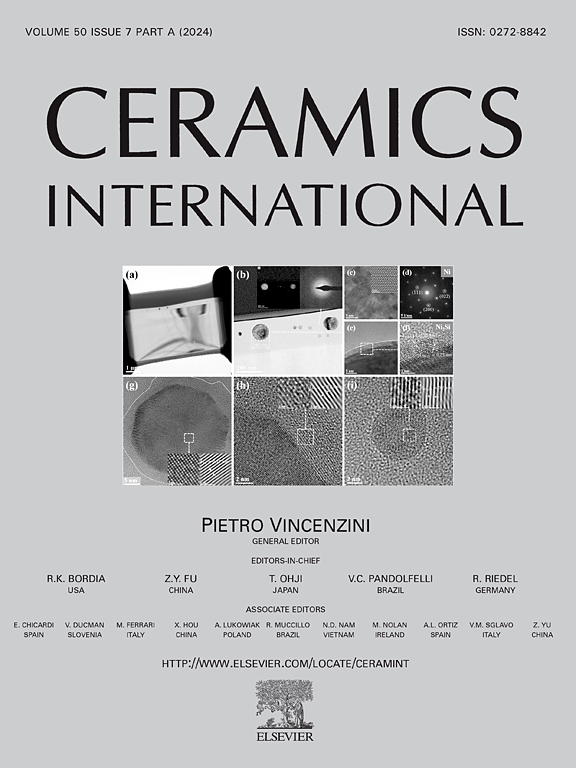Exploring dual optical responses of Polyaniline-Fe2O3 nanocomposites for advanced optoelectronic and supercapacitor applications
IF 5.6
2区 材料科学
Q1 MATERIALS SCIENCE, CERAMICS
引用次数: 0
Abstract
This work investigates the synthesis of nanocomposites and explores their possibility for diverse applications in electromagnetic interference shielding, sensor development, energy storage devices, and dye adsorption. We implemented an optimized electrochemical polymerization method to incorporate controlled concentrations (1, 3, 6, and 12 wt%) of Fe2O3 NPs into the polyaniline (PANI) matrix to investigate the influence of iron oxide nanoparticles (Fe2O3 NPs) on PANI composite properties. To understand structure-property relationships, a comprehensive characterization of synthesized hybrid nanocomposites was undertaken. This analysis focused on their structural properties, dielectric behavior, and linear and nonlinear optical responses. The Williamson-Hall method (W-H) was employed to determine crystallite size and account for the contribution of lattice strain within the material. Williamson-Hall analysis revealed an average crystallite size ranging from 91 to 128 nm. Interestingly, the initial incorporation of low concentrations of Fe2O3 NPs into the PANI matrix led to a decrease in crystallite size. This suggests an interaction between the PANI chains and the nanoparticles that hinders their crystal organization. However, this trend reversed with the addition of higher Fe2O3 NP concentrations, resulting in an increase in crystallite size likely due to nanoparticle aggregation. Incorporating Fe2O3 NPs led to more intense absorption bands and increased absorption coefficients in the nanocomposites compared to the pristine PANI film. This observation suggests enhanced light absorption efficiency within nanocomposite materials. Conversely, the dielectric constant (εr and εi), which represent a material's ability to store electrical energy, exhibited lower values in the PANI-Fe2O3 composites than pure PANI. PANI exhibited a high specific capacitance (Csp) of 477 F g−1, indicating its potential for efficient supercapacitor applications. This study demonstrates that Fe2O3 NPs effectively manipulate the nonlinear optical properties of polyaniline. The observed trends, including the decrease in crystallite size and its influence on optical parameters, underscore the unique properties of the PANI-Fe2O3 nanocomposite system. These findings position these materials as strong contenders for uses in optoelectronics and energy storage devices.
探索聚苯胺- fe2o3纳米复合材料在先进光电和超级电容器中的双光学响应
这项工作研究了纳米复合材料的合成,并探索了它们在电磁干扰屏蔽、传感器开发、能量存储设备和染料吸附等方面的多种应用的可能性。为了研究氧化铁纳米颗粒(Fe2O3 NPs)对聚苯胺(PANI)复合材料性能的影响,我们实施了一种优化的电化学聚合方法,将控制浓度(1、3、6和12 wt%)的Fe2O3 NPs加入到聚苯胺(PANI)基体中。为了了解结构-性能关系,对合成的杂化纳米复合材料进行了综合表征。分析了它们的结构特性、介电特性以及线性和非线性光学响应。采用Williamson-Hall方法(W-H)确定了晶体尺寸,并解释了材料内部晶格应变的贡献。Williamson-Hall分析显示平均晶粒尺寸在91 ~ 128 nm之间。有趣的是,低浓度的Fe2O3纳米颗粒最初掺入聚苯胺基体导致晶粒尺寸减小。这表明聚苯胺链和纳米颗粒之间的相互作用阻碍了它们的晶体组织。然而,随着Fe2O3 NP浓度的增加,这一趋势发生了逆转,导致晶体尺寸的增加,这可能是由于纳米颗粒聚集。与原始聚苯胺膜相比,加入Fe2O3纳米粒子导致纳米复合材料的吸收带更强,吸收系数更高。这一观察结果表明纳米复合材料的光吸收效率提高。相反,表征材料存储电能能力的介电常数εr和εi在聚苯胺- fe2o3复合材料中表现出比纯聚苯胺更低的值。聚苯胺表现出477 F g−1的高比电容(Csp),表明其具有高效超级电容器应用的潜力。该研究表明,Fe2O3纳米粒子可以有效地控制聚苯胺的非线性光学性质。观察到的趋势,包括晶体尺寸的减小及其对光学参数的影响,强调了聚苯胺- fe2o3纳米复合体系的独特性质。这些发现使这些材料成为光电子和能量存储设备中强有力的竞争者。
本文章由计算机程序翻译,如有差异,请以英文原文为准。
求助全文
约1分钟内获得全文
求助全文
来源期刊

Ceramics International
工程技术-材料科学:硅酸盐
CiteScore
9.40
自引率
15.40%
发文量
4558
审稿时长
25 days
期刊介绍:
Ceramics International covers the science of advanced ceramic materials. The journal encourages contributions that demonstrate how an understanding of the basic chemical and physical phenomena may direct materials design and stimulate ideas for new or improved processing techniques, in order to obtain materials with desired structural features and properties.
Ceramics International covers oxide and non-oxide ceramics, functional glasses, glass ceramics, amorphous inorganic non-metallic materials (and their combinations with metal and organic materials), in the form of particulates, dense or porous bodies, thin/thick films and laminated, graded and composite structures. Process related topics such as ceramic-ceramic joints or joining ceramics with dissimilar materials, as well as surface finishing and conditioning are also covered. Besides traditional processing techniques, manufacturing routes of interest include innovative procedures benefiting from externally applied stresses, electromagnetic fields and energetic beams, as well as top-down and self-assembly nanotechnology approaches. In addition, the journal welcomes submissions on bio-inspired and bio-enabled materials designs, experimentally validated multi scale modelling and simulation for materials design, and the use of the most advanced chemical and physical characterization techniques of structure, properties and behaviour.
Technologically relevant low-dimensional systems are a particular focus of Ceramics International. These include 0, 1 and 2-D nanomaterials (also covering CNTs, graphene and related materials, and diamond-like carbons), their nanocomposites, as well as nano-hybrids and hierarchical multifunctional nanostructures that might integrate molecular, biological and electronic components.
 求助内容:
求助内容: 应助结果提醒方式:
应助结果提醒方式:


